
Daily Dose Of Jazz…
Johnny St. Cyr was born on April 17, 1890 in New Orleans, Louisiana. St. He led several bands in the Crescent City beginning around 1905 and performed on the riverboats with Fate Marable. He played for several leading New Orleans bands including A.J. Piron, the Superior, Olympia and Tuxedo bands before moving to Chicago, Illinois in 1923 with King Oliver.
He is most commonly remembered as a member of Louis Armstrong’s Hot Five and Hot Seven bands. He also played and recorded with Jelly Roll Morton’s Red Hot Peppers. St. Cyr also performed with Don Cook’s Dreamland Orchestra. He composed the popular standard Oriental Strut, noted for its adventurous chord sequence.
In 1930 Johnny returned to New Orleans to make a living as a plasterer while still playing with local bands led by Paul Barbarin or Alphonse Picou. In 1955 he moved to Los Angeles, California and returned to music full time. From 1961 until his death in 1966, he was the bandleader of the Young Men from New Orleans that featured Barney Bigard, performers at Disneyland.
Banjoist and guitarist Johnny St. Cyr passed away on June 17, 1966 in Los Angeles, California.
Sponsored By

Voices From The Community
![]()
#preserving genius
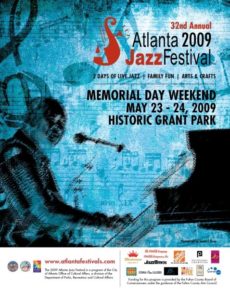
Atlanta Jazz Festival… 2009
It was 2009, the second year of the Piedmont Park Conservancy’s lawn restoration endeavor and it worked. However, the festival was still unable to return for the memorial Day Weekend festivities. The grasses had gone too long and the audiences had taken advantage of the pleasure it had given them over the years. But new rules were in the making for all future festival goers to have a great time. A new dog run was built to accommodate all owners, no charcoal grilling except in the designated park grills or on gas grills. Tents were designated to the hillsides or at the back of the field so everyone could see. Piedmont Park was looking forward to being spectacular and bringing back the festival again.
So on May 23rd and 24th jazz fans and enthusiasts turned their vehicles to Grant Park to enjoy the music. Unfortunately it was music as only Freddy Cole was the national jazz artist representing along with J. C. Young Middle School Jazz Ensemble and Rialto Jazz for Kids All Stars. Booked for the two-day event were other genres of jazz including former Lenny Kravitz drummer Cindy Blackman and her Quartet, Dionne Farris, Hiroshima, Madoca, Mausiki Scales and the Common Ground Collective, Russell Gunn & Elektrik Butterfly and VINX. #AJF40
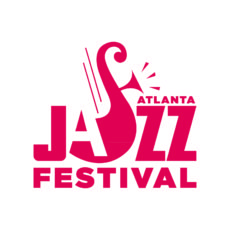
![]()
#preserving genius
More Posts: festival,forty,free,history,jazz,music,tradition,years
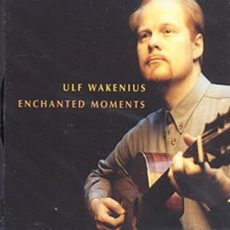
Daily Dose Of Jazz…
Ulf Karl Erik Wakenius was born April 16, 1958 in Halmstad, Sweden and raised in Gothenburg. In the 1980s he played with Peter Almqvist in Guitars Unlimited during the intermission for 600 million viewers of the Swedish International Finale of the Eurovision Song Contest in 1985. He went to Rio de Janeiro, Brazil that same year and began recording the first of three records with Sivuca, Aquarela Do Brazil, followed by Rendez-Vous in Rio in 1986 and Let’s Vamos in 1987.
During the Eighties Ulf collaborated with Niels-Henning Ørsted Pedersen also started this decade, and during the mid to late Nineties they recorded Those Who Were and This Is All I Ask. He led the U.W. Group, releasing Venture with Jack DeJohnette on drums, Bill Evans and Bob Berg on saxophones, trumpeter Randy Brecker, pianist Niels Lan Doky, Chris Minh Doky and Lars Danielsson on bass. In 1994 he recorded New York Meeting with Niels Lan Doky, Ira Coleman and Billy Hart.
He would go on to work with Lars Jansson, Lars Danielsson, Raymond Karlsson, Gösta Rundqvist, Yasuhito Mori, Jukkis Uotila, Carsten Dahl, Morten Lund, Lars Danielsson, Haakon Graf, John Scofield, Dennis Chambers, Gary Grainger, Oscar Peterson, Michel Legrand, Ray Brown, Pat Metheny Jon Larsen, Stian Mevik, Jimmy Rosenberg Lisa Nilsson, Cæcilie Norby, Viktoria Tolstoy, Esbjörn Svensson and Youn Sun Nah among others.
Guitarist Ulf Wakenius,a member of of Oscar Peterson’s last quartet from 1997 and a member of the Ray Brown trio, continues to lead his own band and record.
Sponsored By
www.whatissuitetabu.com
![]()
#preserving genius
More Posts: guitar
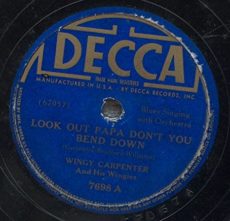
Daily Dose Of Jazz…
Theodore “Wingie” Carpenter was born on April 15, 1898 in St. Louis, Missouri. He lost his left arm as the result of an accident during his early teens, with the amputation performed by a noted surgeon who was an uncle of jazz musician Doc Cheatham. Sometime later, he took up the trumpet and by 1920 he was working in traveling carnival shows, and in 1921 he toured with Herbert’s Minstrel Band.
By 1926 he had settled in Cincinnati, Ohio and worked with Wes Helvey, Clarence Paige, Zack Whyte, and Speed Webb. In 1927, Wingie played in Buffalo, New York, with Eugene Primus. Off and on from late 1926 through 1928, he was featured on the Whitman Sisters’ Show with pianist Troy Snapp’s band.
During the early 1930s the trumpeter was featured with Smiling Boy Steward’s Celery City Serenaders and another Florida band led by Bill Lacey. In the mid-1930s, he became a touring regular with bandleaders including Jack Ellis, Dick Bunch, and Jesse Stone. By the late 1930s, Carpenter settled in New York City, where he worked with Skeets Tolbert and Fitz Weston.
From 1939 on, Wingie worked as the leader of his own band through the 1960s, playing occasional dance dates and working for periods at well-known clubs such as The Black Cat, The New Capitol, Tony Pastor’s The Yeah Man, and other venues. He composed several works not limited to Look Out Papa Don’t You Bend Down, Preachin’ Trumpet Blues, Put Me Back In The Alley, Rhythm of The Dishes and Pans, and Team Up.
Trumpeter, vocalist and bandleader Wingie Carpenter, who was one of several one-armed trumpeters who worked in the music business, including similarly nicknamed Wingy Manone, passed away on July 21, 1975 in New York City.
Sponsored By
![]()
#preserving genius
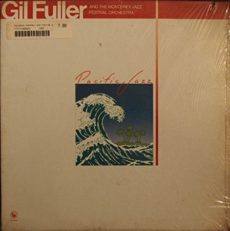
Daily Dose Of Jazz…
Walter Gilbert Fuller was born on April 14, 1920 in Los Angeles, California and is no relation to the jazz trumpeter and vocalist Walter “Rosetta” Fuller. In the 1930s and 1940s he did extensive work writing and arranging for bandleaders such as Les Hite, Floyd Ray, Jimmie Lunceford, Billy Eckstine, and Tiny Bradshaw.
He also worked with Benny Carter, Benny Goodman, Woody Herman, Count Basie, Machito and Tito Puente. Following World War II, Gil found himself increasingly in demand as a bebop arranger along with fellow modern arrangers Tadd Dameron, Gil Evans, and George Russell. Fuller’s work with Dizzy Gillespie was of particular note, yielding the tunes “Manteca”, “Swedish Suite”, and “One Bass Hit”. He is the composer of the jazz standard ballad “I Waited For You”, co-credited with Dizzy Gillespie.
Fuller started his own publishing company in 1957, and while he continued to work with some jazz musicians including Stan Kenton in 1955 and again in the 1960s, he also branched out into film music and pop with Ray Charles, among others.
Arranger Gil Fuller recorded a few albums before he passed away on May 26, 1994 in San Diego, California.
#preserving genius
More Posts: arranger




